EVGA, the Z590 Dark motherboard could arrive very soon

EVGA
Months after its announcement last January, EVGA has finally opened the official web page dedicated to its next flagship Z590 Dark motherboard. Hopefully, this means we'll see EVGA's new flagship on sale shortly, so we can see if it deserves to be one of the best motherboards on the market. Most likely, it will be one of the most interesting products for those interested in pushing Intel's Rocket Lake processors to the max in overclocking. It features a 21-phase power subsystem, large copper heatpipes and two DIMM slots for maximum efficiency.Credit: EVGA The cooling that EVGA has used for the VRM and power system is one of the most sturdy ever implemented on a motherboard, with copper heatpipes and tons of fins covering almost the entire back and center of the board. To confirm this, two PWM fans have been employed near the rear I / O that will push air directly onto these heatsinks for even greater cooling potential.
The card also features hard touch buttons for power and sleep capabilities, plus dual multi-function POST indicators for detailed troubleshooting. EVGA hasn't skimped on storage solutions, offering up to three M.2 slots, one of which is compatible with PCI Express 4.0. All three are housed under a large heat sink for further cooling.
Credit: EVGA The layout of the Z590 Dark is also very different from the typical ATX / E-ATX motherboard, with many of the components repositioned and reoriented in a different position than one might expect. The 24-pin connector has been repositioned at a right angle and the 8-pin EPS power connectors have been placed right next to the 24-pin connector, also at a right angle. In addition, this area of the board has been recessed, giving the Dark better compatibility with the ATX chassis and its holes for better cable management. The CPU and memory area have also been changed, with the socket rotated 90 ° and the slots positioned on the top of the board instead of the right.
EVGA did not explain why it took so long to publish the official specifications of the Z590, but we can assume that the pandemic, along with the current semiconductor shortage, is the main culprit. Unfortunately, a precise date of the product launch has not yet been given.
If you are looking for a good power supply for your configuration, you will find the EVGA Supernova 850GS at an attractive price on Amazon.
EVGA GeForce RTX 3080 Ti FTW3 Ultra review: Pure souped-up power
The new GeForce RTX 3080 Ti is basically a 3090, but for gamers, we said in our review of Nvidia’s Founders Edition model. The GPU inside is barely cut-down, and while the RTX 3080 Ti gets half the memory of its bigger sibling, 12GB of GDDR6X is capable of handling even the most extreme 4K gaming workloads. It’s just the thinnest of hairs slower than the 3090 in games. “This is the GeForce card that deep-pocketed gamers should buy,” we said.
If you’re looking for a suitable hot rod to house that screaming-fast GPU, look no further than EVGA’s RTX 3080 Ti FTW3 Ultra. This massive, feature-laden flagship tames the RTX 3080 Ti in ways that Nvidia’s dual-slot Founders Edition simply can’t. The FE card is almost as fast as the GeForce RTX 3090, yes. But the EVGA FTW3 Ultra is just as fast as an RTX 3090 thanks to its hefty overclock and abundant cooling. At $1,400, you’re paying a $200 premium for the extra ferocity on top of the 3080 Ti’s sky-high base price. Viewed through another lens, the EVGA RTX 3080 Ti FTW3 Ultra is an extremely high-quality custom graphics card that goes toe-to-toe with baseline RTX 3090 models for $100 less.
You know, if graphics card prices weren’t outrageously inflated even more right now. This card is selling for between $1,700 and $1,900 on Ebay at the time of writing this review. Sigh. Regardless, the FTW3 Ultra rocks. Let’s dig in.
The EVGA GeForce RTX 3080 Ti FTW3 Ultra holds no surprises. It features the same core GPU as every Nvidia RTX 3080 Ti, but tames it with the company’s spectacular high-end FTW3 custom cooling and design, which we’ve already fallen in love with in the Ultra versions of the EVGA RTX 3080 FTW3 and RTX 3070 FTW3. This is a spectacular graphics card.
Let’s kick things off with a refresher on the RTX 3080 Ti’s central specifications, compared to its direct predecessor:
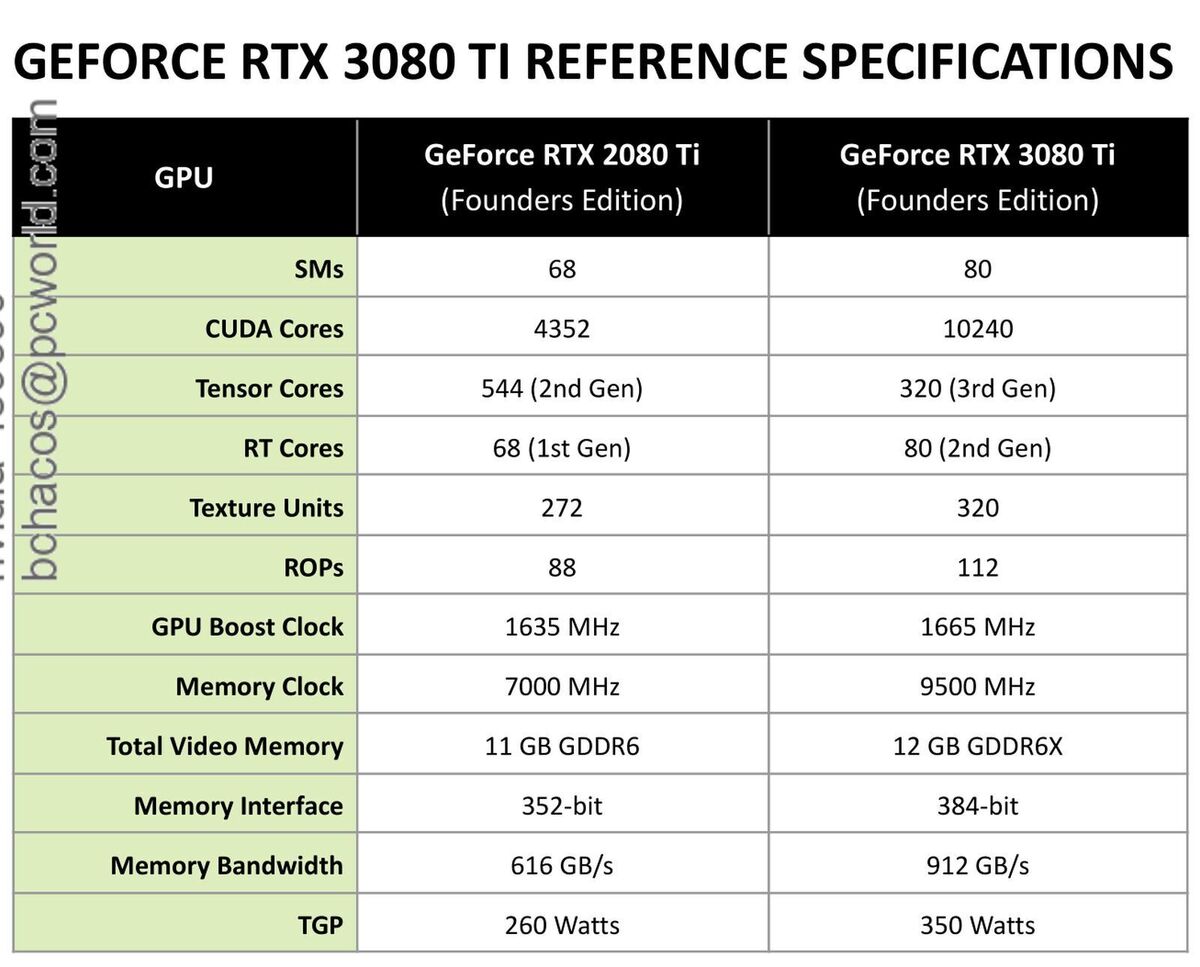 Nvidia
Nvidia...and then take a peek at EVGA’s specification sheet for the FTW3 Ultra specifically:
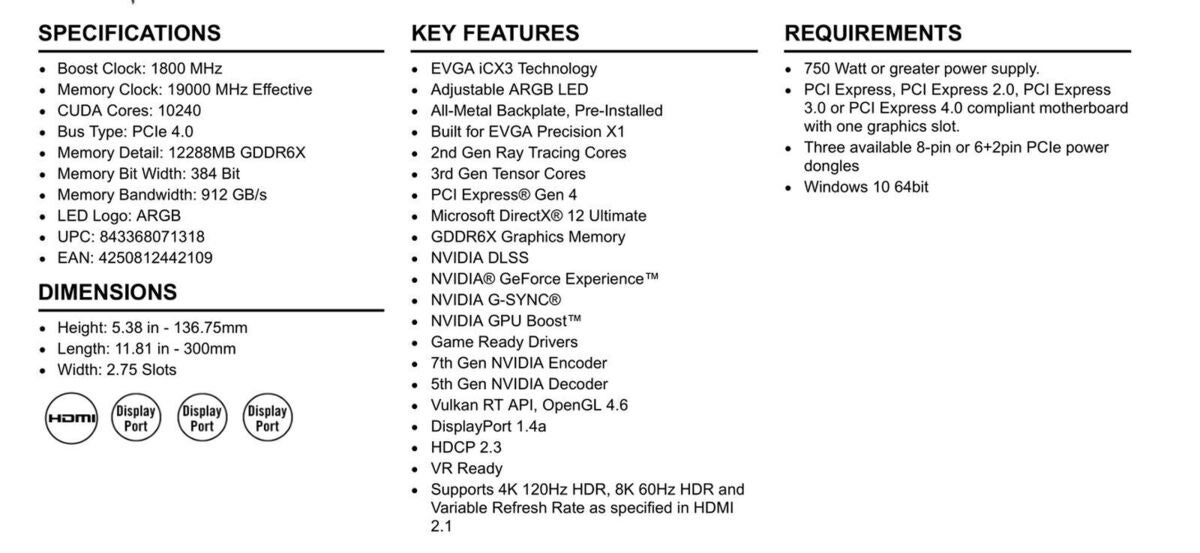 EVGA
EVGAMost of the details align perfectly, as you’d expect. You find the same number of CUDA, ray tracing, and tensor cores in both the FTW3 Ultra and the Nvidia Founders Edition model, along with the same 12GB of ultra-fast GDDR6X memory that can handle any gaming tasks thrown at it with ease. (We covered GDDR6X’s advancements and Nvidia’s new “Ampere” GPU design in-depth in our original GeForce RTX 3080 FE review.) Both also feature the new “Lite Hash Rate” anti-mining technology that nerfs the production of Ethereum cryptocoins on every freshly made Nvidia GeForce GPU besides the RTX 3090.
There’s one massive difference between Nvidia and EVGA’s cards: clock speeds. While the GPU used in Nvidia’s Founders Edition model stuck to reference 1.67GHz boost speeds, EVGA pushed clocks all the way up to 1.8GHz in the ferocious FTW3 Ultra. Interestingly, EVGA still calls for the same 750-watt power supply required for the Founders Edition. As you’ll see in our power benchmarks later, the faster speeds result in significantly higher energy usage for this card—well more than even the RTX 3090 draws. Plan on choosing a bigger power supply just to be safe. The FTW3 Ultra requires a trio of 8-pin power connectors, up from the Founders Edition’s duo, to drive even more power into the card during overclocking attempts.
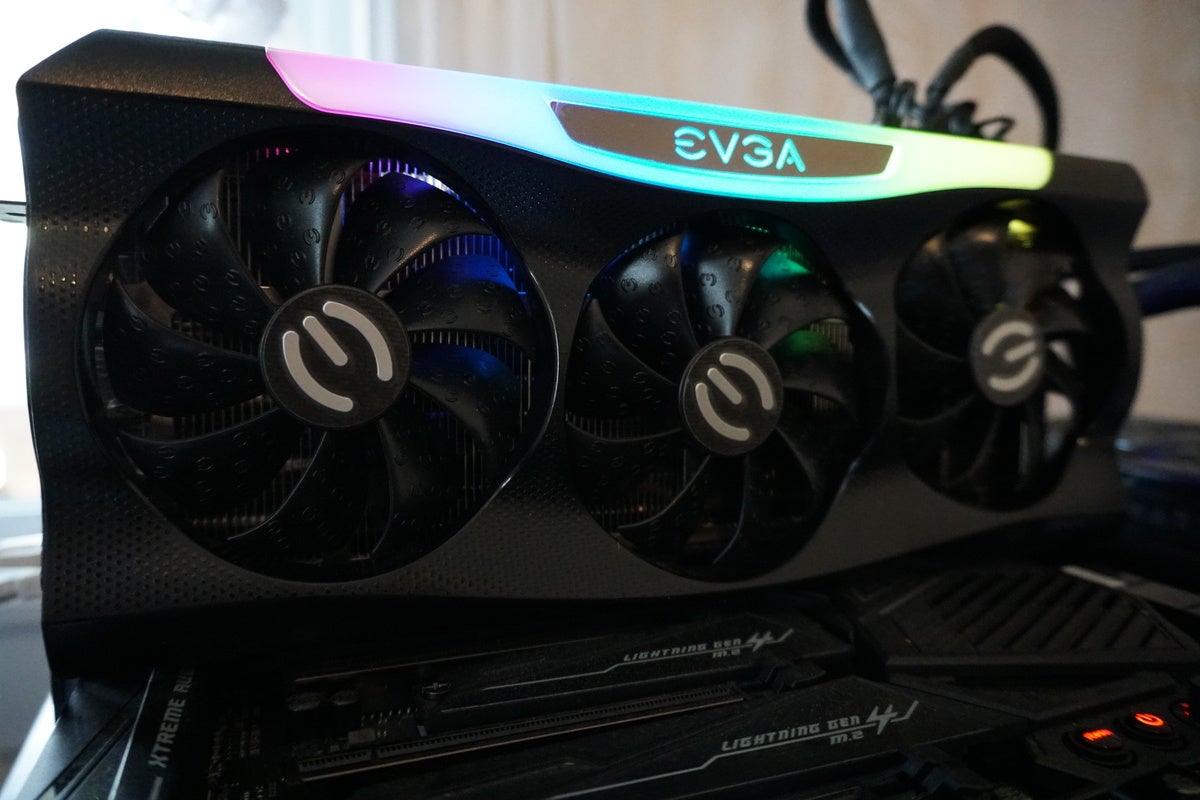 Brad Chacos/IDG
Brad Chacos/IDGNot that you need to overclock it. EVGA pushes this already-powerful GPU so hard that even the extravagant FTW3 Ultra custom cooler can barely contain it. While the 3070 and 3080 versions of the FTW3 Ultra ran much cooler and quieter than their Nvidia Founders Edition counterparts, the RTX 3080 Ti FTW3 Ultra actually runs a bit warmer than the FE despite its heftier three-slot design and abundant fans. It sounds about the same in action.
Don’t let that dissuade you from the card, though. The FTW3 Ultra cooler remains fantastic; EVGA is simply using it to push the RTX 3080 Ti beyond even the RTX 3090’s performance. Driving that home, while some custom cards include a “Quiet” BIOS switch as an alternative, EVGA instead equipped the FTW3 Ultra’s secondary BIOS with an “OC” profile that disables the card’s idle fan stop feature and raises fan speeds to give you extra overclocking headroom.
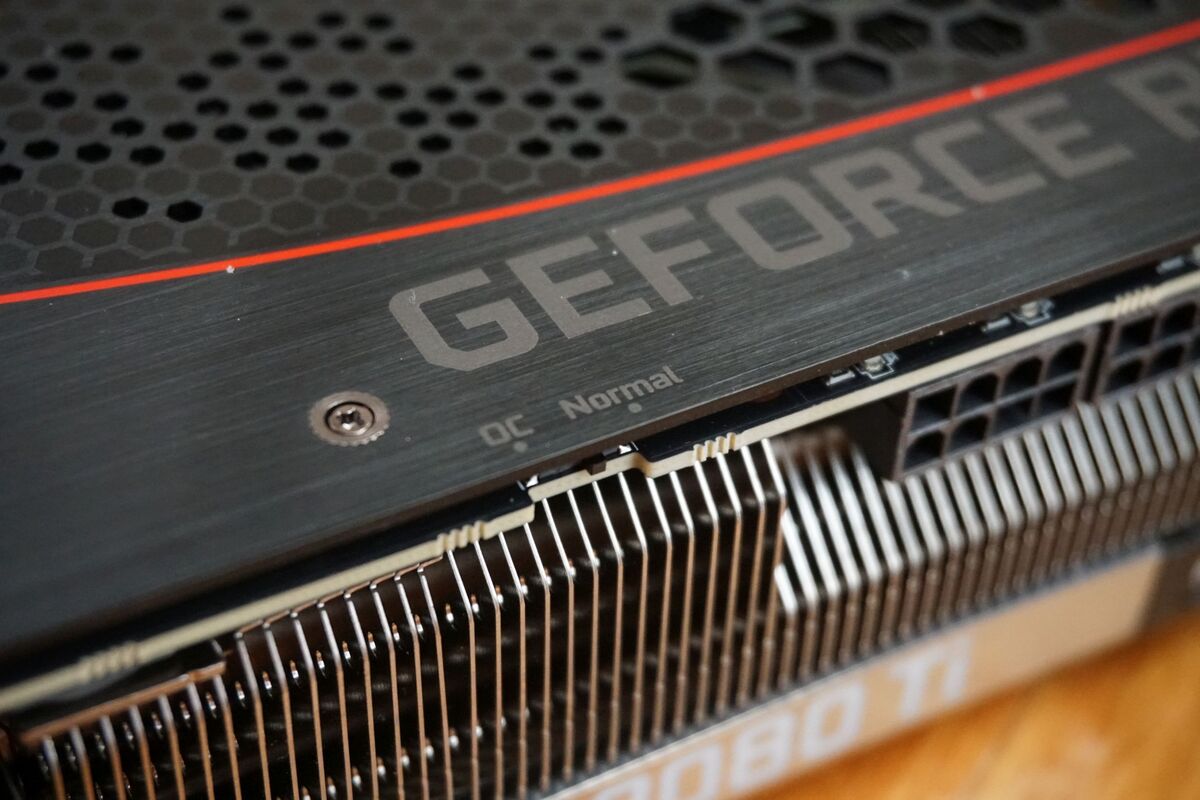 Brad Chacos/IDG
Brad Chacos/IDGThe dual-BIOS switch with a secondary OC profile sits to the left of the card’s trio of 8-pin power connectors.
The company’s GPU management software, Precision X1, remains best-in-class. It lets tinkerers push performance even further with granular overclocking features and the ability to raise the power limit even further. Precision X1 also lets you tap into the not one, not two, but nine “iCX3” sensors that EVGA embedded throughout the card, letting you see temperature readings for different parts of your GPU, memory, and voltage regulation systems. It remains a killer exclusive feature for graphics card nerds and can help you keep an even closer eye on your overclocking endeavors.
Speaking of which, EVGA’s entire high-end cooling design revolves around iCX now. Here’s an excerpt from our RTX 3080 FTW3 Ultra review; the technical details remain applicable for the 3080 Ti FTW3, too.
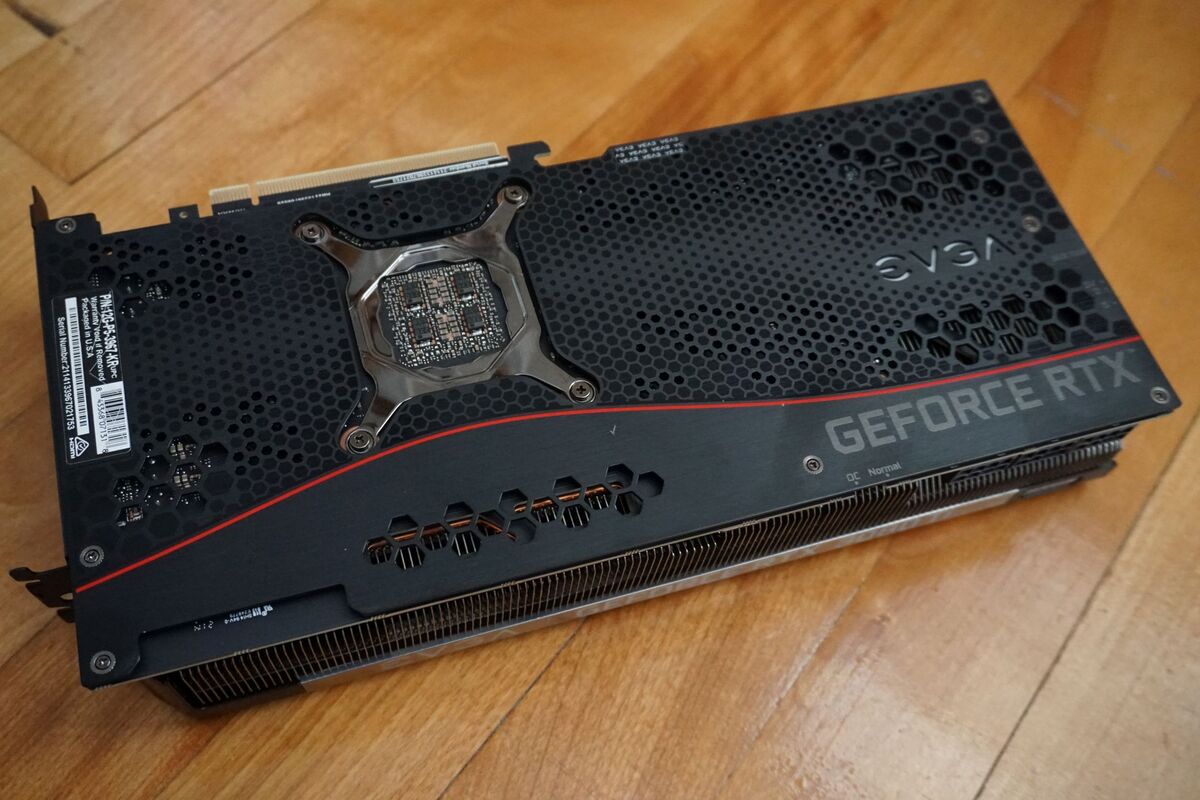 Brad Chacos/IDG
Brad Chacos/IDG“The RTX 3080 [Ti] FTW3 Ultra features three large second-generation “HDB” fans in its wavy shroud. Their asynchronous control lets each fan respond independently to the actual temperature conditions inside your card, pulling data from those iCX sensors. Better yet, they won’t spin whatsoever if your GPU temperatures are under 55 degrees Celsius, so you’ll enjoy silent, passively cooled operation during standard desktop usage. EVGA also offset the center fan by 10mm, which the company claims helps to “increase the direct airflow area by 16 percent.”
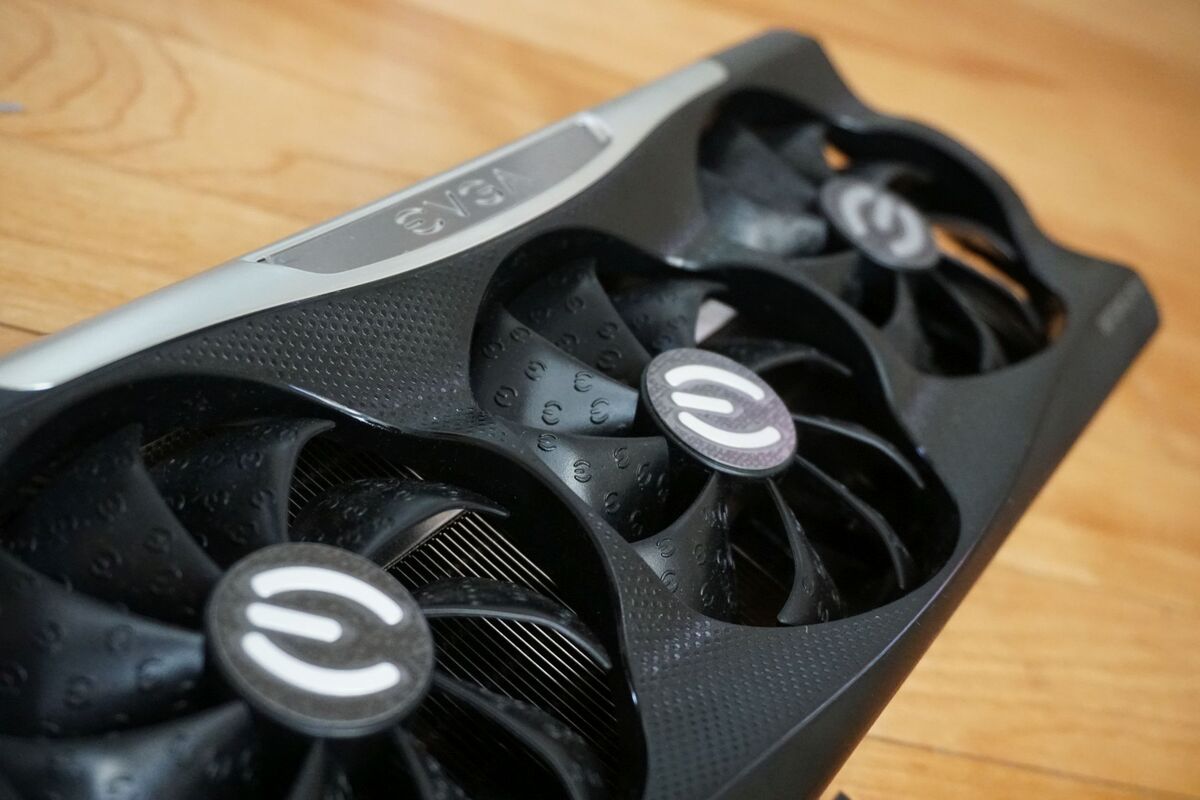 Brad Chacos/IDG
Brad Chacos/IDG“There’s indeed plenty of metal for that air to cool. EVGA slapped an absolutely massive heatsink on this triple-slot card. It’s infused with “180-degree” semi-circular heatpipes that EVGA says increases contact area by 65 percent, and bolstered by a large, unified copper block helping to keep both the GPU and memory cool. EVGA says it redesigned the heatsink to allow air to move more freely throughout, then matched that with cut-outs in the custom PCB and aluminum backplate to let air flow through the card (perhaps in a nod to the Founders Edition’s unique flow-through design).”
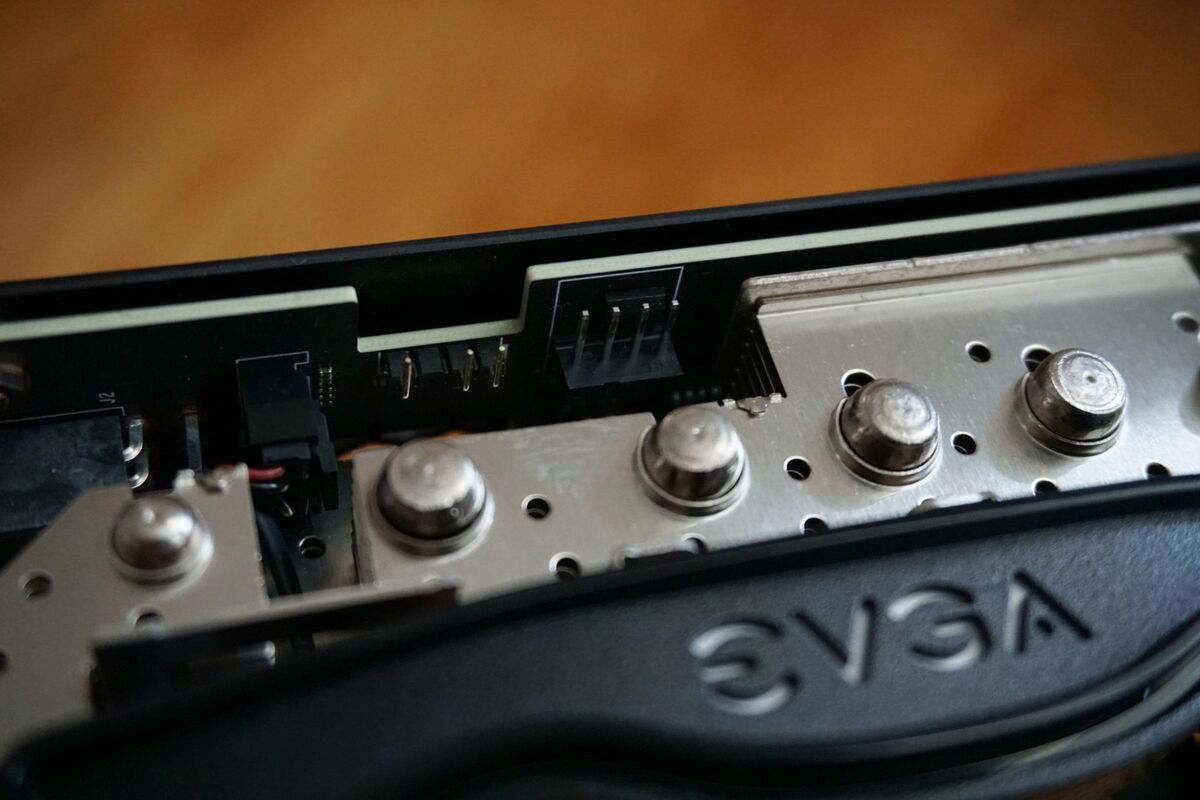 Brad Chacos/IDG
Brad Chacos/IDGThe ARGB and PWM headers sit at the rear of the FTW3 Ultra.
“…EVGA also equipped the FTW3 Ultra with a PWM fan header on the end of the card. You can plug one of your case’s PWM fans into it and have the fan be intelligently controlled by the graphics card’s temperature directly, rather than by your motherboard. Cards like the similarly high-end Asus ROG Strix have offered this before, and it proves especially handy if you use your card to control a front case fan pointed directly at the GPU. Next to the fan header, you’ll find an ARGB header that you can plug into your motherboard to tie it together with your graphics card’s chosen lighting.”
Considering the iCX sensors, dual-BIOS switch, ARGB and PWM headers, and (of course) abundant customizable lighting embedded in the card’s shroud, the EVGA GeForce RTX 3080 Ti FTW3 Ultra includes pretty much every luxurious extra you could ask for—a very good thing in a $1,400+ graphics card.
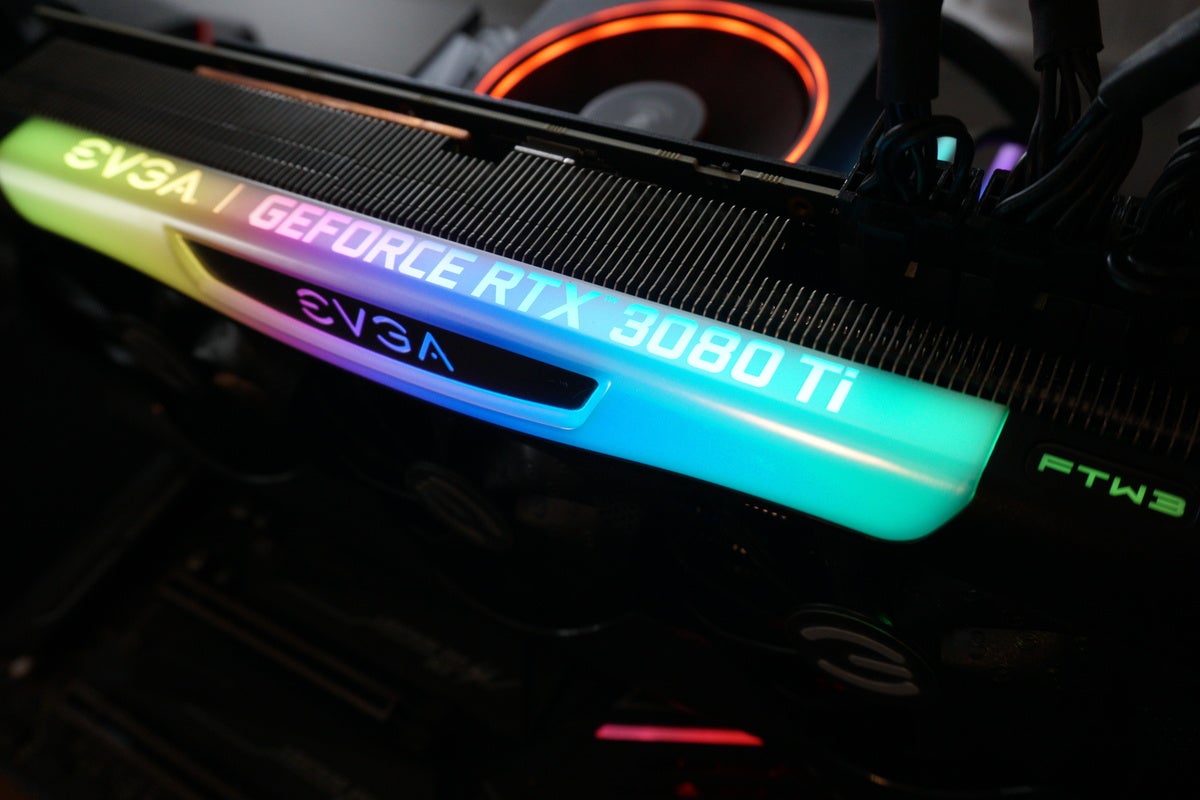 Brad Chacos/IDG
Brad Chacos/IDGBut just how fast can it go with all that heavy metal? Let’s take it to the test bench.
Next page: Our test system, benchmarks begin